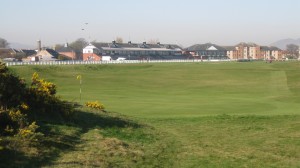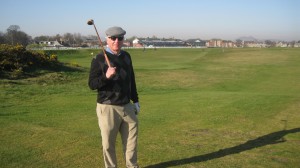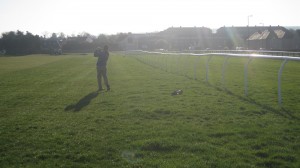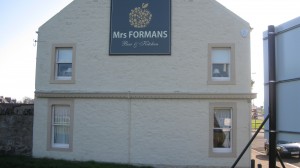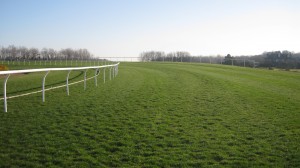Eighth in a series
MUSSELBURGH, Scotland – Musselburgh Links was a golf course when the game was called gowff, when only shepherds played, when clubs were made of hickory and balls were feather-filled leather pouches.
Say what you want about St. Andrews – the ancestral home of golf that was the first 18-hole course in the world – but folks here have documented proof that the Musselburgh Links was the first golf course. Even the skeptical folks from Guinness Book of World Records have confirmed that Musselburgh is the oldest, continuously played course in the world.
The course, just northeast of Edinburgh along the coast, originally was only seven holes. One was added in 1838 and another in 1870 to make the nine holes it is today.
Official records go back to March 2, 1672 when golf was played here, although it has been reputed that Mary, Queen of Scots was on the course on Feb. 10, 1567. The reason why that date’s remembered is because she played just hours after the murder of her husband, Lord Darnley.
Other than that, Your Majesty, how was your round?
Today, Musselburgh Links sits inconspicuously inside a horse racetrack. That’s not the greatest marketing plan for a golf course when your signature hole is also the far turn.
The racetrack meeting is usually around 28 days. The times vary from afternoons to night racing. The one rule the course has to follow is that all golf play must be completed an hour and a half before the first race.
That’s a relative inconvenience to the local golfers here. As one patron told me, “this holds a special place for us.”
You wouldn’t know it from the street but history exudes from the property. Some of the points of significance here are:
* King James VI played here in 1603.
- Oliver Cromwell set up camp on the grounds in 1650.
- The first-ever women’s competition was held here in 1811.
- The racetrack was incorporated in 1816.
- The Honourable Company of Edinburgh Golfers, the oldest (with records) golf club in the world that now oversees stately Muirfield, was a prominent force here from 1836 to 1891.
- The width of the holes at Musselburgh was 4 ¼ inches. That became the standard for the world, officially set by the Royal & Ancient Golf Club in 1893.
- The device to make a golf hole also was first used here in 1829.
- The brassie, in which a metal plate was attached to a wooden hosel, was invented here.
- It’s believed that the harder rubber-moulded gutta-percha ball, the ‘guttie,’ that made golf accessible to the masses, was introduced here in 1848.
- Legendary Bobby Jones played here in the 1920s and took detailed notes of the third hole with the idea of copying it for a course in America. Augusta? Really?
- From 1872 up to 1892, the Open Championship was played alternately on St. Andrews, Prestwick and the Musselburgh Links.
- The course has hosted the Open six times, 1874, ’77, ’80, ’83, ’86 and ’89. It’s only nine holes so the players played it twice. Champion Willie Park, Jr., won it in 1889 and took home six pounds as the winner’s share. Today, the Open champion receives 900,000 pounds.
As part of our Scotland golf experience, my son Bobby and I couldn’t resist playing on such hollowed grounds. Not only that, we elected to rent hickory staff clubs to enhance our old-world round.
We were given five clubs, a heavy-mallet driver, a thin putter, a two-iron, five-iron and a wedge of some sort. The rusted clubs looked like Willie Park, Jr.’s originals. Bobby had ‘reject’ stamped on his five iron.
Asked how the clubs perform, the starter, Jimmie (just Jimmie) said, “I don’t know. I’ve never used them.”
Then I asked him if any professionals had played here and he showed me the guest book. There was the signature of Sandy Lyle, the Scottish star who won the 1985 Open and 1988 Masters. He played here in November.
Scores didn’t matter for us on this day, not with the hickorys. Rather, we sought a connection to the past. Despite a course mostly inside a white-rail racetrack, this place once had significance. The greatest players played here. This was a renowned place at one time. We tried to appreciate all that but from the looks of it now, it would take a leap of faith.
You walk from the clubhouse, across the outside edge of the grass racetrack and through an opening in the white railing. The first hole is a 240-yard, par-3. We had no idea how the ball would respond on impact from this weighty mallet-head driver. I put a swing on it and lined it about 60 yards in the air then it just kept rolling. The topspin applied by the club was enormous as the ball rolled up the slope to the green then over it. I can’t hit my new technology three wood that far.
The second hole tee box is right in front of the grandstands and it parallels the front straightaway. In fact, the next three holes are all alongside the straightaway, with No. 4 actually extending onto and through the track’s grass surface.
The fourth hole is the most famous. The par-4, 431-yarder, is the second longest on the course. You tee off inside the track but you hit over the curving racetrack rail and toward the eastern-most section of the property. It’s where fairway and straightaway converge.
At the end of the fourth is the original Mrs. Forman’s house, about three centuries old. Back in the day, golfers would walk up to the kitchen window and order lunch and a drink to take you through the final five holes. Now it’s a bar and you’ll need to go around in front to get in.
As we approached the fifth hole, one of the maintenance guys approached us.
“You guys can’t play from the metal (back) tees,” he said. “That’s only for championship play.”
My first thought was: Championship?’ What championship? The Open ain’t coming back here, pal.
That shortened the course from 2,954 yards to 2,734, enough for double-eagle opportunities.
The sixth hole, a par-3, 183 yards, is completely outside the racetrack. We then climbed a small hill and went back through the rail again for the final three holes inside. And down the stretch we went.
The longest hole is the par-5, 479-yard seventh, in which I caught a bunker and ended up with a 7. That ancient hickory wedge actually worked pretty efficiently out of the bunker.
We had to wait a bit longer to tee off on No. 8, a 240-yard, par-3. Now only did the group ahead of us have to clear the green but there’s a public path about 100 yards from the tee. Dog-walker after dog-walker passed through, leaving no other option but to hold our hickorys.
Talking to some members afterward, you can see why this is a special place for them. They relish the history. It’s cheap and a snap to get around. And it’s accessible for disabled players. During out round, we saw two fellows in motorized wheelchairs having a go at it.
The new Musselburgh Old Course Golf Club, formed in 1982, is attempting to recapture the essence of the old links. The group purchased the original clubhouse out of foreclosure in the mid-1990s and is restoring the 19th Century Victorian to its past glory.
If you are a serious golfer, there isn’t a lot to convince you to play here, although Sandy Lyle likely didn’t come here as an Open tuneup. It’s not particularly challenging, it’s restricted by a racetrack, it’s not maintained to the highest standards and it’s only nine holes. But it’s historic. It’s significant. It’s gowff as you can imagine it was. It’s a timeless monument to the game that’s worth your time.





